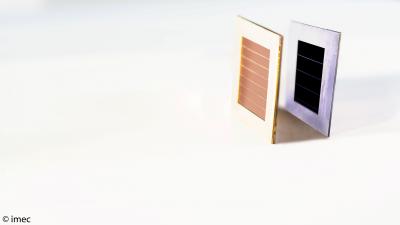imec, the world-leading research and innovation hub, recently presented an impressive thin-film tandem solar cell at the EU PVSEC conference. The cell consists of a top perovskite cell developed by imec within the partnerships of EnergyVille and Solliance, and a bottom CIGS cell from the Centre for Solar Energy and Hydrogen Research (ZSW, Stuttgart, Germany). The tandem cell resulting from this collaboration achieves a record efficiency of 24.6%.

The perovskite top cell in the tandem uses light in the visible part of the solar spectrum, while the light in the near-IR spectrum that passes through the perovskite cell is harvested by the underlying CIGS cell. In this way, the tandem cell significantly outperforms the stand-alone perovskite and CIGS cells. Moreover, both perovskite and CIGS cells are thin-film solar cells, paving the way to high efficiency flexible solar cells and building integrated photovoltaic (BIPV) solutions.
The 4-terminal tandem consists of a perovskite solar cell placed on top of a CIGS cell, based on a fully scalable device concept to enable the feasibility of industrial adoption of the process. The new record efficiency of 24.6% was reportedly achieved thanks to several innovations. First of all, the transmittance of the perovskite cell for near-IR light was improved by adding optical coupling layers to the tandem stack and by optimizing the transparent electrodes. In addition, the perovskite itself was optimized in terms of a wide bandgap of 1.72eV for higher tandem efficiency.
The CIGS cell of 0.5cm2 size has been made at the high-efficiency line at ZSW, employing all optimized processes necessary for the preparation of record devices. It thus was the ideal sample for combination with the perovskite cell. Further improvements of the technology will ultimately pave the way to thin-film tandem solar cells with efficiencies of more than 30%.
'We work on two types of tandem cells,' explains Tom Aernouts, group leader for thin-film photovoltaics at imec/EnergyVille. 'We combine our state-of-the-art perovskite technology with silicon or CIGS bottom cells. The advantage of CIGS is that it is a thin-film technology, just like perovskite, and that the tandem cells therefore can be fabricated in a wide variety of shapes and sizes. This makes it possible to use this technology in building-integrated PV applications. Future work will focus on upscaling the technology towards larger modules. Moreover, we will also look into developing solutions for 2-terminal cells because of their importance to the PV industry. In the end, it's the adoption of our results by our industrial partners that's important.'
'We owe the record efficiency to two factors,' says Prof. Dr. Michael Powalla, member of the board and head of the Photovoltaics Division at ZSW. 'On the one hand to the improved perovskite cell, on the other hand to one of the world's best efficiencies for CIGS cells. There are several parameters of the CIGS cell which we can optimize with regard to its combination with the perovskite top cell. Thus, we expect even better efficiency values in the future, paving the way to further cost reductions.'

